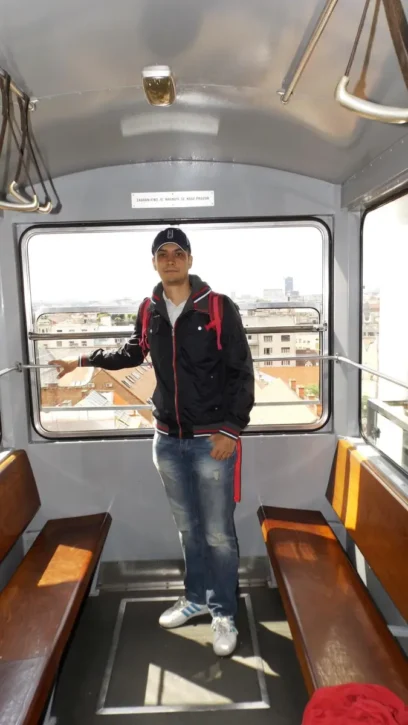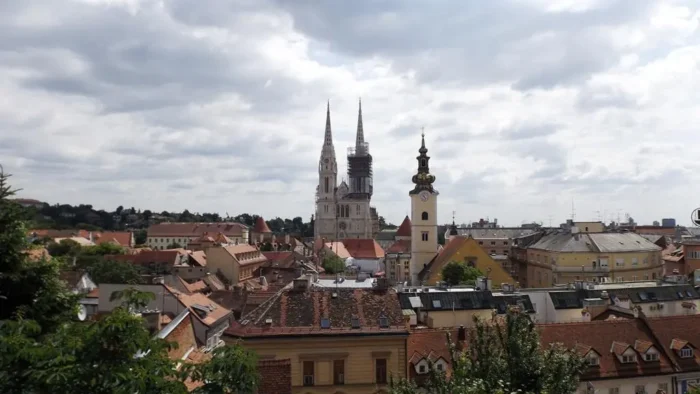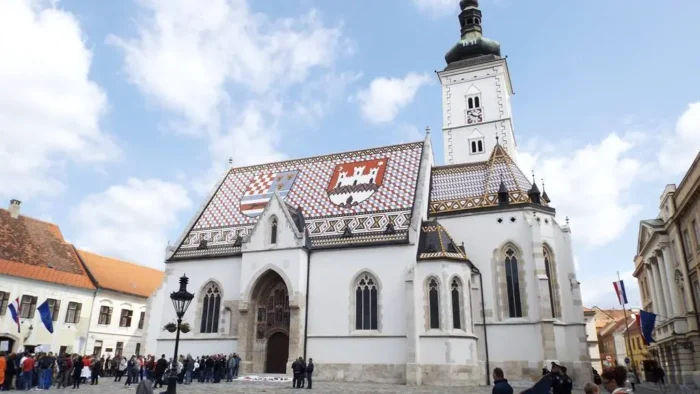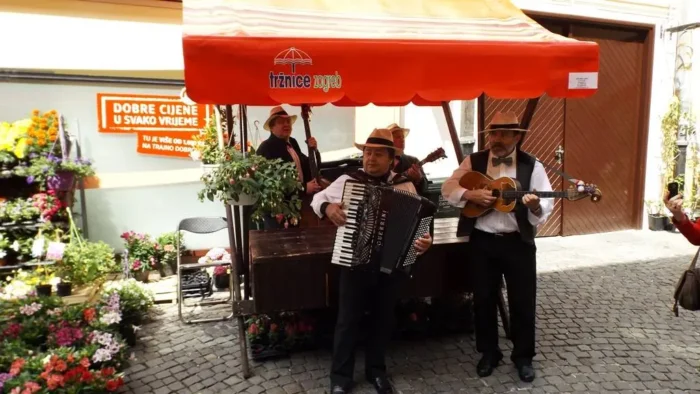Zagreb is a city divided into two halves that perfectly complement each other: the historic Upper Town (Gornji Grad) and the elegant Lower Town (Donji Grad).
The first, dating back to the 11th century, is filled with cobblestone streets and red-tiled rooftops, being – without a doubt – the most romantic part of Croatia’s capital.
And it is my favorite part of Zagreb, too. Every time I visit, I make sure to go to this old town area first, even if it’s only for a cup of great coffee on Tkalčićeva Street and some people-watching. (Here’s one of my favorites.)
The Upper Town is the perfect part of Zagreb: excellent for walking, with less traffic overall, with amazing restaurants and pubs, but still maintaining that medieval charm. Also, two-thirds of Zagreb’s attractions are concentrated between the two hills here, Kaptol and Gradec. So there are plenty of reasons to love this part of the city.
Getting to Zagreb’s Upper Town
If you’re starting from Ban Jelačić Square, Zagreb’s main square, you have two options: you can walk uphill to the Upper Town or take the funicular, known locally as Uspinjača.
It’s one of the shortest funiculars in the world – just 66 meters long – but it saves your legs from the climb. And it’s an interesting experience. Here is me riding the short funicular:

Normally, the ride costs €0.66 and takes less than a minute, with the trains running every 10 minutes. Sometimes, on special occasions, it is even free to ride (that was the case last time I visited, when it was probably some celebration I wasn’t aware of). But even the ticket cost is minimal…
When you reach the top, you’ll find yourself at the Strossmayer Promenade, with one of the most beautiful views of the city below and the Zagreb Cathedral in the background.
If you travel from other parts of the city, you can also rely on public transportation: I have a full guide to Zagreb public transport system here.
Walking Through the Upper Town
The best way to experience Gornji Grad is on foot, in my opinion. Every corner can hide a nice secret or treat, and every street can end up with a surprise. Here is a route you can follow to check out most of the main attractions, with a few hidden gems sprinkled in:
Strossmayer Promenade

Even if you don’t take the funicular here, this is where you should start your trip – and start with some amazing views over the lower town area.
The promenade stretches along the old city walls, and it’s best visited during the summer when you have local artists and musicians on the streets, while the small cafes outside serve their coffee under chestnut trees. If you’re here at sunset, you’re visiting at the perfect time of the day!
Lotrščak Tower
Close by, the Lotrščak Tower guards the old southern gate. Climb to the top for a 360° view of Zagreb (although, if you’re in a hurry, I have to admit that the view from the promenade alone should be enough).
Each day at noon, a cannon fires from the tower, marking midday for locals and tourists. It’s a tradition dating back to the 19th century (going since 1877), and probably one of the longest-running in the country.
Stone Gate (Kamenita Vrata)
Next, walk through the Stone Gate, a small chapel built into the last remaining medieval gate of Gradec.
Inside, a centuries-old painting of the Virgin Mary survived a devastating fire in 1731, making the locals consider it truly miraculous. Either way, it’s one of the most peaceful corners of the busy capital.
St. Mark’s Church

Just ahead is the colorful St. Mark’s Church, Zagreb’s most photographed landmark, and the one you probably know already thanks to its tiled roof, decorated with the coats of arms of Croatia and the city of Zagreb
The church dates back to the 13th century, and while its interior is only open during services, the exterior alone is worth the walk.
St. Catherine’s Church
Before heading down from St. Mark’s, take a small detour to the nearby St. Catherine’s Church, a Baroque beauty built by Jesuits in the 17th century.
Inside, you’ll find marble altars and intricate ceiling frescoes, all beautiful and impressive, especially when compared to the modest facade you can see from outside.
Dolac Market
From there, walk back toward Dolac Market, known as the belly of Zagreb. Since 1890, it’s been the city’s main farmers’ market, buzzing with chatter and filled with local produce, flowers, and souvenirs.
Come early in the morning when locals shop and vendors shout across the stalls trying to lure you in – that’s when it feels most alive and it’s an interesting experience, even if you don’t buy anything (but chances are slim that will happen).

Zagreb Cathedral
Overlooking Dolac is the majestic Cathedral of the Assumption of the Blessed Virgin Mary, Croatia’s tallest building and another iconic attraction.
While some debate whether or not it’s part of the Upper Town area (technically, it’s not), many consider it part of it, so I’m listing it here. It’s a must-see anyway in Zagreb.
Its twin spires dominate the skyline and can be seen from almost anywhere in the city.
Even though it was heavily affected by two earthquakes in 2020, restoration work is ongoing and the cathedral remains a defining landmark and spiritual heart of the city.
Grič Tunnel
Before you leave, stop by the Grič Tunnel, originally built during World War II as a bomb shelter.
Today it connects the Upper and Lower Towns through a 350-meter-long underground passage. It’s free to enter, open daily from 9 AM to 9 PM, and occasionally hosts art exhibitions or installations.
Off the Beaten Path
Now, for a few gems that you might not find otherwise. I recommend walking up (or down) Opatička Street, one of the oldest in Zagreb. There are various amazing buildings, like the ones at number 10 and 18 – but plenty more.
Also, if you decide to visit St. Catherine’s Church recommended above, there is a tiny terrace behind it, but one offering a majestic panorama of the city below. This is lesser known by tourists, and it’s usually empty, so you can take some amazing photos here.
Museums Worth Visiting
While most museums in Zagreb are located in the Lower Town, a few in Gornji Grad are worth setting aside time for – and I am listing them in a separate category, as I know that some people like them, while other don’t.
However, you will find here some of the most unique museums ever and they are definitely worth visiting.
Museum of Broken Relationships
This is by far the most famous – and most unique – museum in Zagreb. It’s exactly what it sounds like: a collection of everyday objects left behind after love stories ended, but each has its own personal story listed. Some are heartbreaking, others are funny, and some are just… strange.
I was surprised to see this exhibit when we visited, as Football Manager is one of the games I spend hundreds of hours playing. Fortunately, it resulted in no broken relationships in my case:

The museum is at Ćirilometodska 2, close to St. Mark’s Church, open 9 AM to 10 PM, and tickets cost around €7. I am marking it here on Google Maps, and I recommend booking your “skip the line” ticket online here.
Note: This has to be mentioned!
Even though not in the Upper Town area (but very close by), there is the Museum of Lost Tales – a unique museum in Europe. Make sure to visit it as well – find more about it and book your ticket here.
Croatian Museum of Naïve Art
Right around the corner from St. Catherine’s Church, this small but captivating museum celebrates Croatia’s folk-art painters, known for their bright colors and imaginative detail – a unique painting style of the region.
It’s a refreshing contrast to the city’s grander galleries and takes less than 30 minutes to visit, but it’s perfect for art lovers.
Wrapping up
Croatia’s capital will surprise you – I had almost no expectations before visiting it, and I was absolutely blown away by its beauty and how much it has to offer. To make sure you don’t miss anything important, check out my full travel guide to Zagreb here.
And if you have additional recommendations to make for those visiting the Upper Town area of the city, don’t hesitate to post a comment below.

